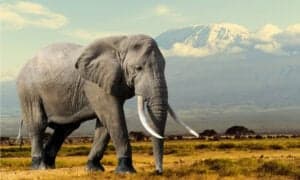Baby elephants might grow to be one of the largest land animals in the world, but they are only around 200 to 300 pounds when they are born. Did you know that young elephants are called calves? Or that elephants lose their tusks much like human babies lose their first set of baby teeth?
Read on for ten elephant baby facts and pictures that show how awesome this giant mammal is.
#10: Baby Elephants Can’t Jump

An elephant calf explores the grasslands.
©iStock.com/slowmotiongli
Elephants are the largest animal in the world that can’t jump. We know what you’re thinking: it’s probably because of their size, right? However, that may not be true. The truth is, scientists don’t know why elephants can’t jump because there hasn’t been enough research done to determine the correct answer.
In addition to not jumping, baby elephants can’t get all four of their feet off the ground at the same time. When they are running, they constantly have at least one foot anchored to the ground. This is thought to promote stability in the animals.
#9: Newborn Elephants Soothe Themselves By Sucking their Trunks
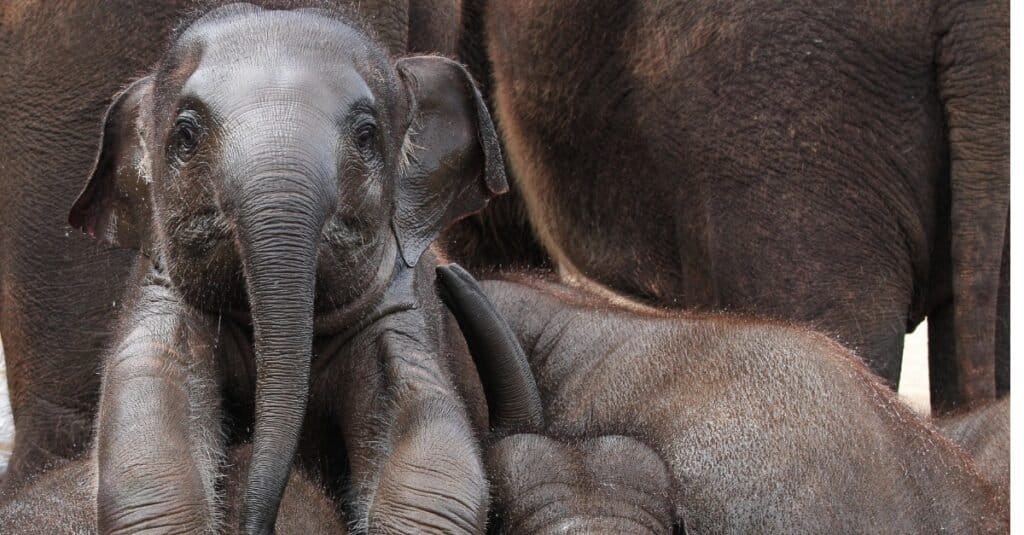
Elephant calves suck their trunks for comfort.
©iStock.com/purea
We all know human babies suck their thumbs for comfort. Did you know that baby elephants do the same thing with their trunks? These tiny giants don’t just do this to soothe themselves, though. It also helps them strengthen their trunk muscles and gain better control over the appendage.
#8: Baby Elephants are Called Calfs and Weigh Around 200 Pounds When They Are Born!
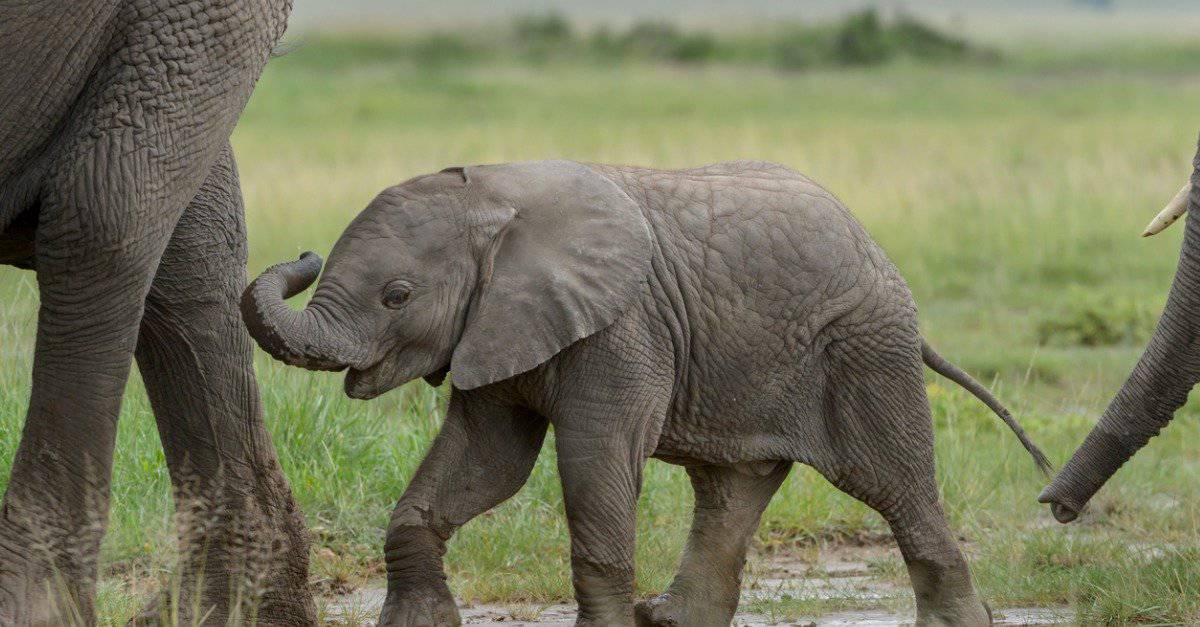
A tiny elephant follows its mother through the grasslands.
©iStock.com/AndreAnita
A baby elephant is called a calf. Groups of baby elephants are called calves. Baby elephants are far from the only species whose young we call calves. For example, the babies of cows are called calves. In addition other large animals like rhino and whales also have babies known as calves!
A newborn elephant usually weighs in anywhere from 200-300 pounds and stands around three feet tall! As they grow up, they rapidly pack on the pounds and will end up weighing up to 15,000 pounds when fully grown. Scientists say that on average, baby elephants gain two pounds a day until they are fully grown. Now that’s a big baby!
#7: It Takes Elephants Nearly Two Years to Give Birth
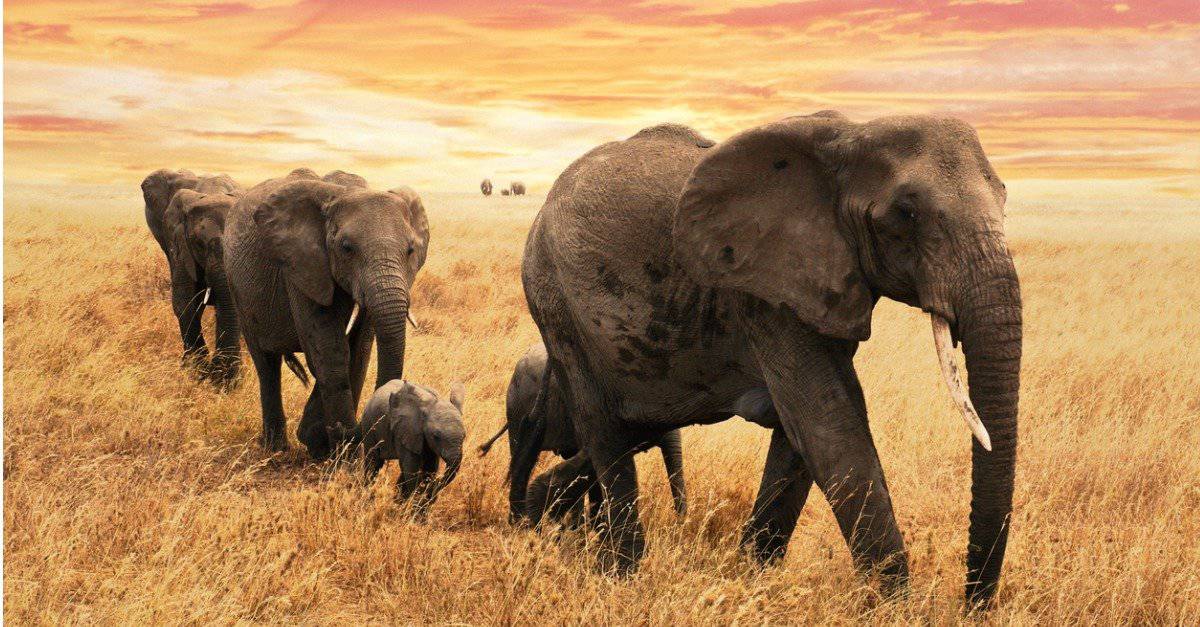
Baby elephants are protected by their families.
©iStock.com/TeamDAF
Did you know that adult elephants are pregnant for 22 months before they give birth to a newborn elephant? It’s true! This gestation period makes the elephant the mammal with the longest-lasting pregnancies on Earth. Elephants are pregnant for so long in part because of the size of their babies – it takes longer to develop a 200-pound newborn!
#6: Baby Elephants Have to Learn How to Use Their Trunks
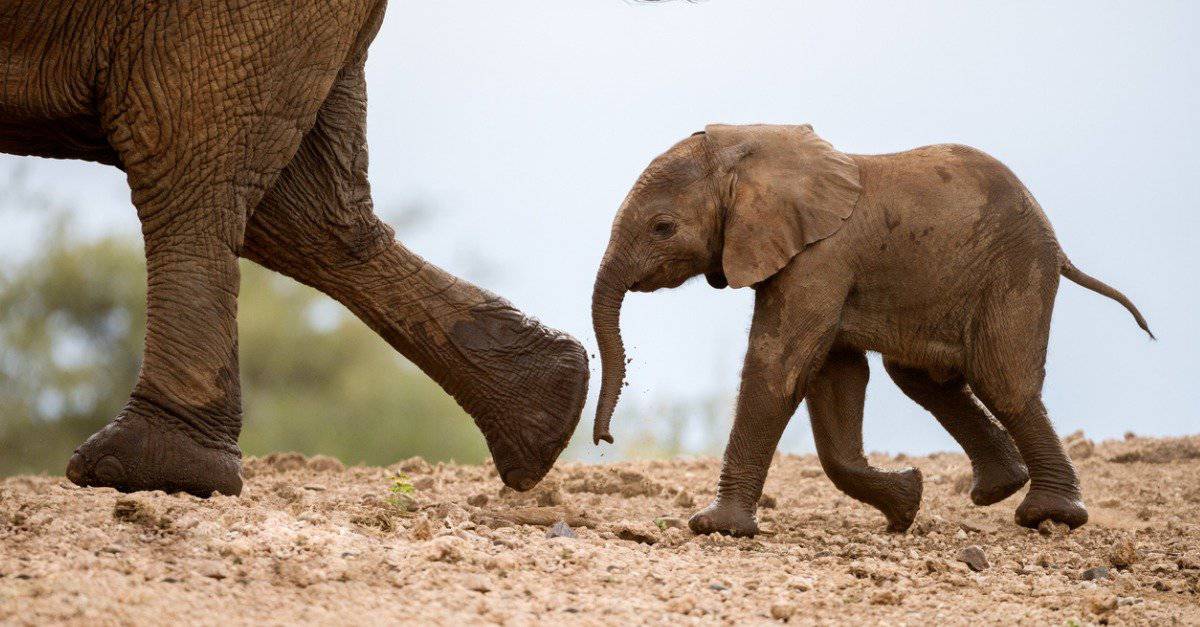
Elephants learn how to use their trunks by swinging them back and forth as they walk.
©iStock.com/Udo Kieslich
You might be surprised to learn that a baby elephant doesn’t instinctively know how to use its trunk. When they are born, they lack muscle tone in their trunks, which makes them difficult to control, so elephants must get plenty of practice in to build strength and dexterity in their trunks. Baby elephants strengthen and learn how to use their trunks by playing in water and swinging it back and forth.
#5: Baby Elephants Lose Their Baby Tusks
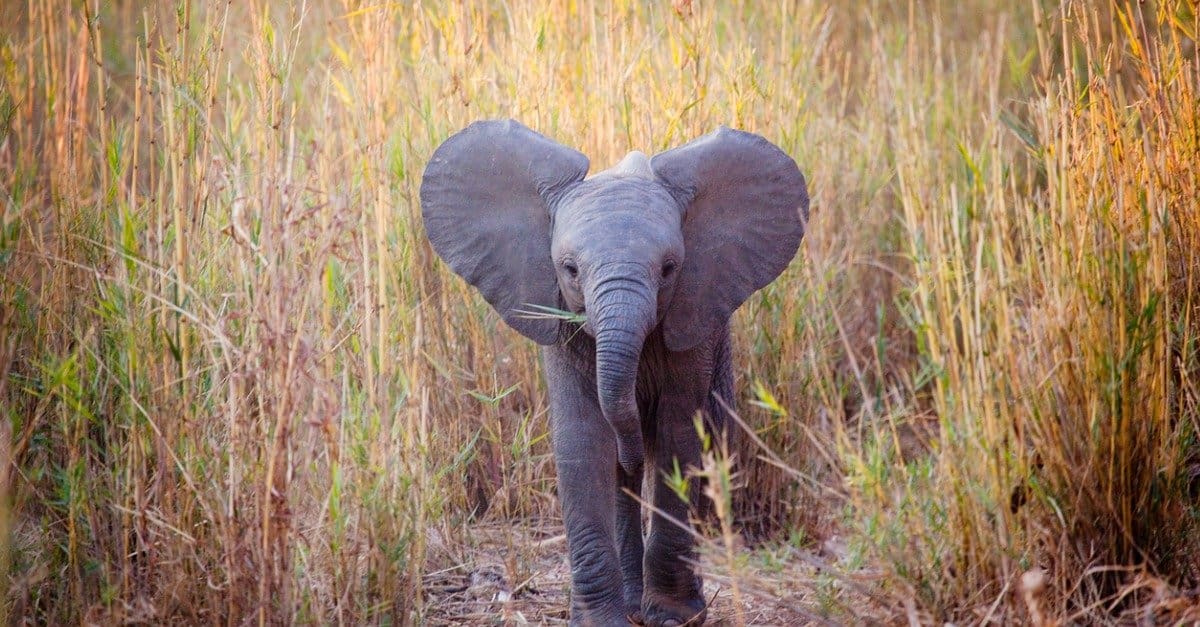
Elephant calves lose their baby tusks.
©iStock.com/samnooshka
If you’ve ever had a visit from the tooth fairy, you know it’s normal for babies to lose their first set of teeth. A baby elephant will shed its tusks the same way! After about one year, they lose their first set of tusks. When they turn two, their adult tusks begin to grow, which continue getting larger until the elephant is fully grown.
#4: Most Elephants are Born at Night

An baby elephant runs alongside its mother.
©iStock.com/StuPorts
An astounding 99% of elephants are born in the evening. Scientists believe that this is an evolutionary trait that elephants developed to protect their young from predators and to promote a calm environment. Elephants have even been known to intentionally disrupt birth when daylight is near.
#3: Elephants are Born Blind
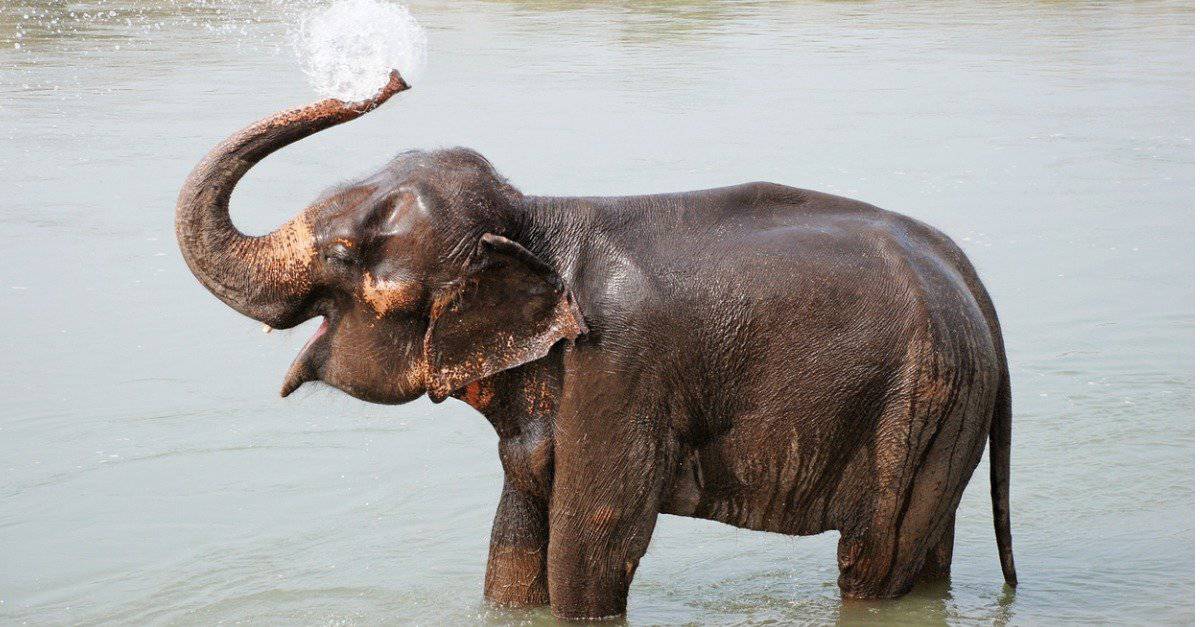
An elephant calf showers itself with water.
©iStock.com/jfoltyn
Even though elephants are mostly developed by the time they are born, their eyesight is not. Even as adults, elephants are not well-known for their eyesight, but as babies, they are nearly blind. Instead of relying on sight, they use their trunks and guidance from their mothers to navigate the world.
#2: Adult Elephants Cover Their Babies in Sand to Protect Them from the Sun

Young elephants are protected from the sun by being coated in sand and dirt.
©iStock.com/gnomeandi
Elephants thrive in grasslands, savannahs, and forest areas where the weather is usually hot and dry. In order to protect their babies from the sun, adult elephants use their giant trunks to shower baby elephants with sand and dirt, which creates a protective layer on their skin to protect them from the sun.
#1: Newborn Elephants Have Nearly Fully-Developed Brains

©iStock.com/GroblerduPreez
It’s easy to imagine that after nearly 2 years in the womb, baby elephants don’t have much more development to do once they are born. A baby elephant is born with a fully-developed brain and unlike many other animals, they can walk immediately after birth, though they may be a bit wobbly.
What is a Group of Giraffes Called?
Many animal groups in the animal kingdom have interesting names. Some of them sound like there was a lot of thought put into them, some of them have some sort of underlying meaning, some of them are difficult to put a finger on, and then there are some of them that make sense, albeit with a touch of humor!
Giraffes are called a “tower” when they are in a group. When you put together their visual characteristics together, it just makes good sense. The term tower perfectly describes how a giraffe appears with their long, slender necks. On top of that, when they appear in a bunch, it definitely makes sense that they would convey a tall, formidable structure!
The photo featured at the top of this post is © John Michael Vosloo/Shutterstock.com
FAQs (Frequently Asked Questions)
What do baby elephants eat?
Most baby elephants exclusively drink their mother’s breastmilk for their first year of life. After that, they usually consume a diet that consists of bamboo, shrubs, herbs, fruits, and roots. Since elephants are exclusively herbivorous, they consume no meat.
Where do baby elephants live?
Baby elephants usually live in the savannah or grasslands, but can also be found in wooded areas, on swampy terrains, and many other places. They thrive best in warm weather in areas where there is plenty of foliage, berries, and grass to eat.
How much do baby elephants weigh?
Newborn baby elephants can weigh anywhere from 200 to 300 pounds! This makes them one of the largest land animals on earth.
What is a baby elephant called?
A singular baby elephant is called a calf. A group of baby elephants are called calves. In addition to elephants, the newborns of many other animals are called calves. For example, rhinos, whales, and hippo babies are call calves.
Thank you for reading! Have some feedback for us? Contact the AZ Animals editorial team.





